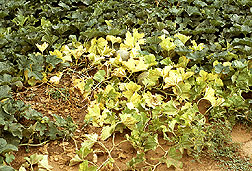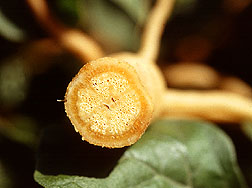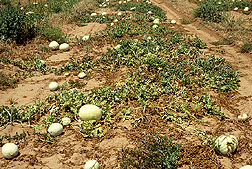A New Melon Disease: Yellow Vine
|
|
Genetic fingerprinting puts researchers on the trail of a cucurbit killer's mystery accomplice.
Yielding the high-tech tools of molecular genetics, researchers are closing in on a stealthy killer. For watermelon and cantaloupe growers in Texas and Oklahoma, it won't be a moment too soon. That's because the killer-at-large is a new cucurbit disease called yellow vine.
In 1991, it first struck the two states' melons and cantaloupes with a vengeance, causing losses as high as 100 percent.
Scientists blame a microscopic, rod-shaped cell called a BLO, or bacterium-like organism. To growers, it's a costly, unpredictable blight that renders its plant victims a yellow, wilted heap of vines, leaves, and runners with unmarketable fruit.
"There's no rhyme or reason to it," says grower Kenneth Weatherly of Terral, Oklahoma. He lost a 250-acre melon crop to the 1991 outbreak.
But welcome news could be in store. Agricultural Research Service and collaborating scientists are gathering evidence suggesting an insect accomplice spreads and infects cucurbit plants with the disease. If that's the case, then melon growers might be able to spray their crops with an insecticide, or use repellent mulches, or perhaps use other anti-insect tactics.
The scientists' chief suspect is a little-known species of leafhopper, a winged insect that can easily infect plants with the microorganism as it probes for sap.
But "it's too early to start jumping up and down for joy," says Benny D. Bruton, an ARS plant pathologist who has led studies of yellow vine. "We need more data."
The key will be showing that the leafhoppers can transmit the BLO to plants and not just carry the microbe in their gut—the incriminating evidence so far. The researchers' next step will be to start monitoring the leafhoppers' movements, feeding behavior, and geographic distribution. That information could give growers an edge in staving off a leafhopper-caused outbreak.
Working with Bruton is Sam D. Pair, an entomologist who heads ARS' South Central Agricultural Research Laboratory in Lane, Oklahoma. They collaborate with Jacqueline Fletcher, Ulrich Melcher, and John L. Sherwood of Oklahoma State University at Stillwater and with Forrest Mitchell of Texas A&M University in Stephenville.
Scientist-Turned-Investigators Take High-Tech Road
Earlier this year, they devised a sensitive new diagnostic test for screening the tissues of leafhoppers and other insect suspects for evidence of the BLO's unique, genetic fingerprint.
|
|
Their approach draws on a standard molecular technique called polymerase chain reaction (PCR) and bits of nucleic acid called primers that latch onto complementary bits of the microbe's DNA. The PCR then makes millions of copies of the genetic material for easier identification, enabling scientists to determine in about 48 hours whether an insect harbors the yellow vine microbe.
By going after the BLO's genetic fingerprint, scientists can avoid confusing it with other disease-causing microbes such as other bacteria and fungi.
In May, the researchers used their new test to sample hundreds of leafhoppers, squash bugs, and other insects. Most were collected from the Cross Timbers vegetational area, where yellow vine outbreaks are most common. Characterized by grassy, rolling hills and trees such as elm, pecan, post oak, and mesquite, the region encompasses portions of central Texas and Oklahoma.
The Cross Timbers was a starting point for clues, says Bruton, but by no means the only region hit by the disease. "It looks like yellow vine may be severe in western Oklahoma this year," he says. "I also had a report from an extension plant pathologist from east Texas who said they may have serious problems."
Yellow vine hasn't yet been detected outside of the two states, where growers last year harvested about 55,000 acres of melons, according to USDA's Economic Research Service.
Melons planted in early spring are often the hardest hit. By planting in March through April, growers can schedule their harvests in time for the July 4th marketing window. That's when the fruit can go for a premium price of 10 to 15 cents a pound. Afterwards, the price can drop to 3 to 5 cents. A bumper crop can yield up to 40,000 pounds per acre, generating an estimated $4,000. But a severe outbreak can snuff growers' profits in just a few days, and they lose the money spent on seed, transplanting, fertilizer, pesticide, and labor.
Eyewitness Accounts
Grower Keith L. Hall of Terral, Oklahoma, remembers the beating melon crops took in 1991 and 1994. "We still have nightmares about that and wonder if we'll wake up tomorrow and find half our field has wilted," he says.
Hall periodically sprays his 450-acre melon crop with an insecticide that kills squash bugs, which he suspects infect the plants as they feed. "It seems to limit the spread of the disease," says Hall, who has escaped major losses over the past few years.
Weatherly, also of Terral, is less sure about spraying. "We don't know what to do," he says. "You can't just go out there and spray. You can't afford it." His 310-acre melon crop has so far remained unscathed.
Joel Hicks of Leon, Oklahoma, hasn't been so lucky. Four years ago, he pulled in about 28,000 pounds of melons per acre from his crop. Then yellow vine settled in. The next year, he only harvested about 10,000 pounds per acre. "This year, I seriously doubt I'm going to get 5,000 to 6,000 pounds," says Hicks, who is now contemplating switching to another crop.
Bruton's group, which has worked closely with Hicks and other growers, shares the frustration. "It's been tough going out there, year after year, with nothing conclusive to tell them," he says.
Before the PCR test, the researchers conducted lengthy—often months-long—greenhouse experiments to see which cucurbit-loving insects could infect melon plants as they fed. In addition to leafhoppers and squash bugs, they also looked at aphids, which tap into the plant's sweet, rich sap.
Likewise, the researchers wanted to see which insects could acquire the disease from an already-infected plant. But no conclusive leads surfaced.
Putting PCR to work has greatly speeded up the process, eliminating insect specimens that may never have carried the disease in the first place.
"What this approach will allow us to do in the future is to conclusively identify the insect vector, see where it overwinters, and monitor its movement," says Bruton. "Because we suspect there may be another plant—perhaps a weed or shrub—acting as a carrier, or reservoir host, of the bacterium, PCR will be crucial to identifying the plant and developing control strategies."
|
|
Taking Action
At best, spraying insecticide is a short-term solution. It can be costly to growers and endanger beneficial insects such as bees.
To find alternatives, the researchers have begun evaluating a few seedless watermelon varieties, called triploids, that have resistance or tolerance to yellow vine disease.
Most melons planted now are seeded varieties. That's chiefly because they germinate more readily, though the plants are highly susceptible.
"The seedless melons go for top dollar," notes Bruton. The hitch: "The triploid is a really wimpy plant in the seedling stage," he says. "But once that plant gets going and establishes itself, it's one of the most vigorous growing, productive plants there is."
The scientists hope to locate the specific gene or genes that help resistant melons stave off the BLO's intercellular assault. This raises the prospect of developing new, resistant, seeded varieties.
On another front, they are exploring planting a few rows of insecticide-treated squash plants as a protective barrier around a melon crop. The tactic capitalizes on an inherent taste that some insect pests have for squash plants over melons, cantaloupes, and other cucurbits. The scientists hope that by feeding on the treated squash, an insect would die before it infected a melon plant. [For more on barrier crops, see "Reviving Trap Cropping," Agricultural Research, September 1997, pp. 16-17.]
Yellow vine or not, Kenneth Weatherly has no immediate plans to stop growing melons. "Once you make a living off of something," he says, "it's hard to just back off." — By Jan Suszkiw,
Benny D. Bruton and Sam D. Pair are at the USDA-ARS South Central Agricultural Research Laboratory, P.O. Box 159, Lane, OK 74555; phone (580) 889-7395.









